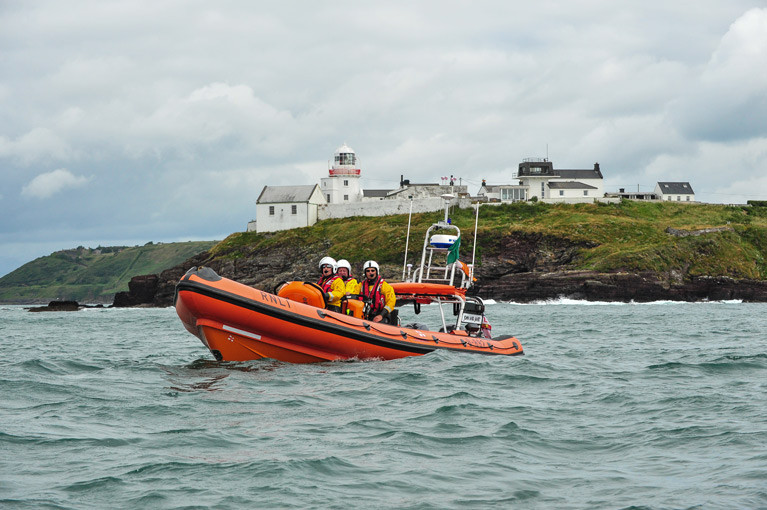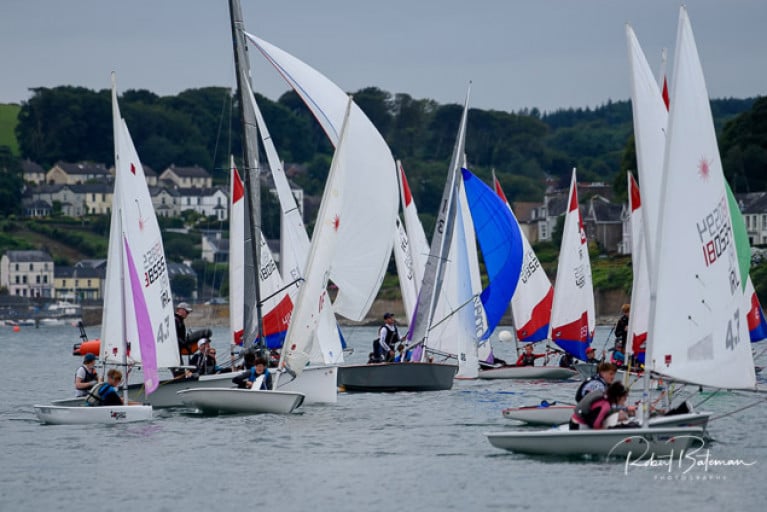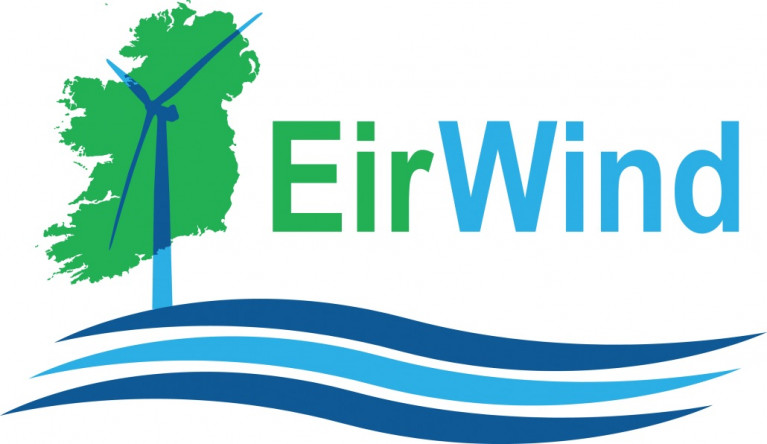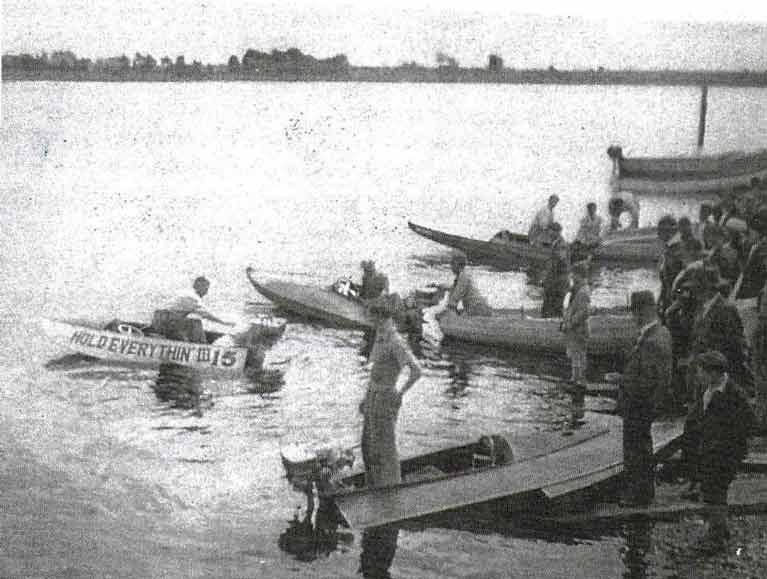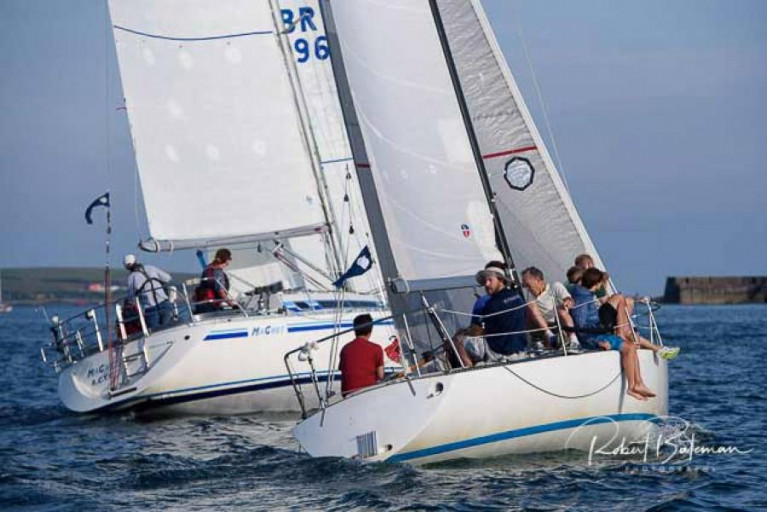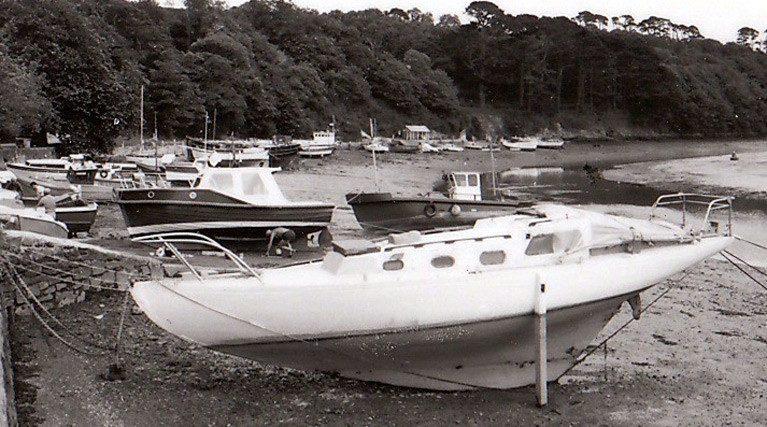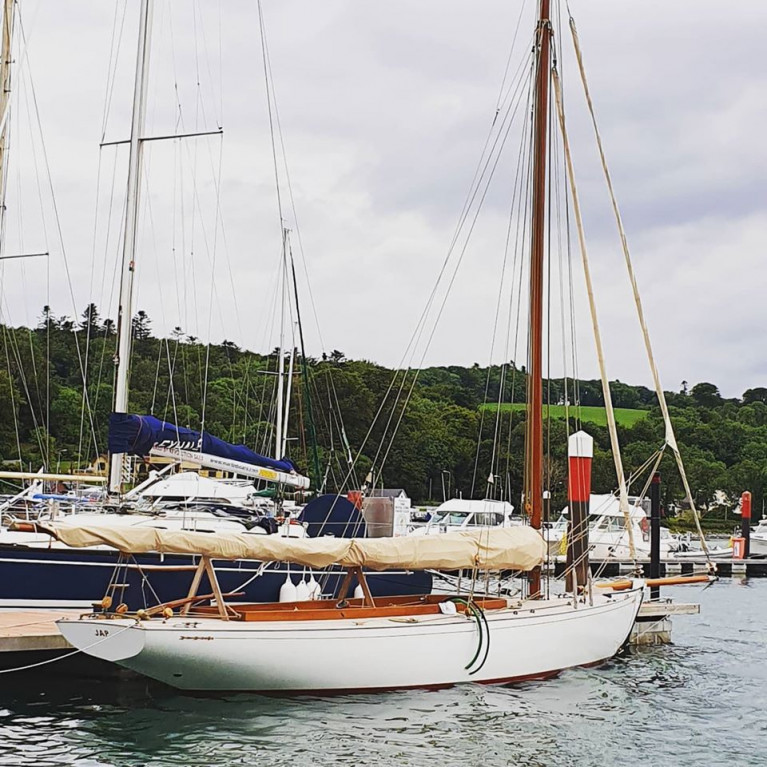Displaying items by tag: Cork Harbour
Crosshaven RNLI Assist Powerboat with Two Persons Onboard
The volunteers of Crosshaven RNLI lifeboat were paged at 5.51 pm this evening (Saturday 19 July) to go to the aid of a broken-down vessel, East of Power Head at the entrance to Cork Harbour.
The lifeboat with Ian Venner in command and with Claire Morgan, Derek Moynan and Jonathan Birmingham on board made best speed towards the Casualty in good conditions and a slight sea.
First reports were that the 23' powerboat with two persons on board had broken down and was at anchor awaiting help.
Enroute, the lifeboat crew was informed by the Coast Guard that the casualty had managed to restart their engine and was slowly making for Ballycotton and would be obliged for the lifeboat to escort the vessel into the harbour.
The lifeboat crew were happy to oblige and saw the vessel safely moored in the harbour at Ballycotton.
Commenting on the incident, helm, Ian Venner said the vessels owner had 'done everything by the book and called the problem into the Coast Guard immediately and then anchored the vessel.'
Launch crew on this call out were Sandra Farrell, Susanne Deane, Richie Leonard and Caomhe Foster. The lifeboat returned to station at 8 pm.
The National 18 crew of Colin Chapman, Owen O'Keefe and Eddie Rice were yesterday's winners of the AIB sponsored PY 1000 cash Prize at the Royal Cork Yacht Club in Cork Harbour.
With only the lightest harbour breeze available Race Officer John Crotty set the mixed dinghy fleet off on a course that involved all points of sailing from a beat,a run and reaches before heading home for refreshments on the RCYC lawn at Crosshaven.
 Royal Cork Race Officer John Crotty had to contend with some fickle winds for the 2020 PY Race Photo: Bob Bateman
Royal Cork Race Officer John Crotty had to contend with some fickle winds for the 2020 PY Race Photo: Bob Bateman
 The PY1000 2020 dinghy course set in Cork Harbour covered all the angles Photo: Bob Bateman
The PY1000 2020 dinghy course set in Cork Harbour covered all the angles Photo: Bob Bateman
Other cash prizes went to second overall to Tom, Cloe and Patrick Crosbie. Third place went to Andrew Crosbie, all sailing National 18s.
 AIB PY 1000 Winners - Colin Chapman, Owen O'Keefe and Eddie Rice Photo: Bob Bateman
AIB PY 1000 Winners - Colin Chapman, Owen O'Keefe and Eddie Rice Photo: Bob Bateman
Chris Bateman won the Lasers and Shane Collins, the Topper division.
Knox Kohl was the youngest sailor and first female home was Sophie Crosbie.
The youngest crewed boat was sailed by Ethel and Olin Bateman and the oldest combined Crew was Tommy Dwyer and Willy Healy
RCYC AIB PY1000 Photos
See the full slideshow of images from the event below by Bob Bateman
The first major Class championships this season and the first in Cork Harbour will go ahead at Cove Sailing Club next weekend. The Squib Southerns will be based at the new Cove SC clubhouse and marina at Whitepoint.
The event and the marina are a big boost for the harbour town. Cobh has long-needed facilities for visiting boats. Several previous attempts to build a marina there failed. Cove Sailing Club, which celebrated its centenary last year, undertook its own project. It was not without difficulties and financial pressures which did create some internal club difficulties. At one stage another club, the Great Island Sailing Club, was formed and organised cruiser racing while remaining club members devoted their attention to getting the marina built. They succeeded, the new marina is now in operation, the clubs have re-united, with Great Island ceasing activities and members back in Cove Sailing Club which is a busy place at present.
 Race Officers get the first race away from Cove Island Sailing Club's new marina pontoons Photo: Bob Bateman
Race Officers get the first race away from Cove Island Sailing Club's new marina pontoons Photo: Bob Bateman
There is also a new clubhouse and dinghy sailing is resuming, with training courses also going ahead.
Kieran Dorgan is Cove Sailing Club’s Commodore and is my Podcast guest this week, discussing the developments and the economic boost which the marina will provide to the town of Cobh. I started by asking him about the Squibs Southern Championships next weekend, with racing on Saturday and Sunday, July 25 and 26:
Cove Sailing Club’S first evening league of the season was won by Commodore Dorgan’s Altair, a First 36.7 David Doyle’s Sigma 33, Musketeer, was second and Norman Allen’s Impala, Nadia, third. Twelve yachts raced.
New Cork Harbour Slipway & Pier Facility at Paddy's Point Includes Floating Pontoon & Gangway
The new public recreation area at Paddy's Point in Cork Harbour now has a new floating pontoon added to the existing marine leisure facilities at Ringaskiddy.
The pier and slipway, that opened in May 2019 is located adjacent to the Beaufort Building in Ringaskiddy and is managed and maintained by the Port of Cork.
The substantial new facilities replace the existing Ringaskiddy slipway and pier and were completed as part of the Cork container terminal development.
This new marine leisure facility is free for the public to use and includes a pontoon to launch leisure craft and a secure trailer park along with picnic benches in a landscaped area for all to enjoy.
 Paddy's Point new Marine Leisure facilties in Cork Harbour at Ringaskiddy Photo: Bob Bateman
Paddy's Point new Marine Leisure facilties in Cork Harbour at Ringaskiddy Photo: Bob Bateman
Cork harbour could become central to Ireland’s development as an international centre for hydrogen energy technology, a new offshore wind blueprint by the Eirwind consortium forecasts.
As The Irish Examiner reports today, Ireland could be exporting bulk hydrogen as part of an offshore renewable expansion.
The Eirwind strategy to 2050 identifies a number of challenges, and calls for Government commitment to specific incentives, marine planning legislation and “transparent” decision-making.
Eirwind is an industry-led, collaborative research project involving University College Cork (UCC) which has been working on a 30-year strategy for harnessing offshore wind energy.
It describes floating offshore wind technology as a “game changer,” and the period 2020 to 2030 as a “defining decade” for investing in green hydrogen and grid reinforcement.
The new Programme for Government has raised a target of 3.5 gigawatt (GW) energy production from offshore wind to five GW by 2030, and specifies the Irish Sea and Celtic Sea for development. It also signals that 30 GW could be derived from the Atlantic coast.
The Eirwind blueprint identifies three “production zones” - the Irish Sea, Celtic Sea and Atlantic Coast- and is expected to recommend master plans for ports from Rosslare, Co Wexford round to Killybegs, Co Donegal,to support offshore wind and wave development.
The report identifies the fishing industry as “the primary stakeholder”,and is expected to recommend that a joint forum between the fishing and offshore wind sectors be established .
It says the recently completed Marine Planning and Development Management Bill, along with the related Maritime Jurisdiction Bill, need to be prioritised.
Eirwind, based at the MaREI centre in UCC is supported by Science Foundation Ireland, and companies include Brookfield, DP Energy, ESB, Equinor, Engie, EDPR, Enerco, Simply Blue, SSE and Statkraft.
More from the Examiner here
July 12, 1903 was also a Sunday, but it was not the sound of Orange bands marching that dominated the River Lee from Cobh to Cork City, but that of powerboat engines competing for what had been envisaged as the “America’s Cup” of motorboating.
Irish-born newspaper mogul Alfred Charles Harmsworth, Viscount Northcliffe, had organised what is known as “the first motorboat race.”
The trophy was the Harmsworth Cup, envisioned by Northcliffe as “a contest between nations rather than between boats and individuals.”
The course was from Cobh (then Queenstown) to Cork City. It was officiated by the Automobile Club of Great Britain and the Royal Cork Yacht Club for boats, as the rule of the race declared “designed and built entirely by residents of the country they represented.”
 Photos from Vincent Delany's new book on the history of motoboating in Ireland
Photos from Vincent Delany's new book on the history of motoboating in Ireland
As reported by Cork newspapers: “A large number of spectators viewed the first mile from the promenade of the yacht club at Queenstown and several thousand people were at both sides of the river at Cork City to see the finish.”
The race was won by a woman – Dorothy Levitt, travelling at nineteen-and-a-half-miles an hour, regarded as an “extraordinary speed for motorboats” in those days.
She was described as “a remarkable sportswoman who had the first proper motorboat designed for high speed, to the specifications of an Australia, Selywn Edge” In later years she would set the world’s first water speed record at 19.3 miles per hour (31.1km/h).
This fascinating story is told by yachting historian Vincent Delany in his book about ‘”The Motor Yacht Club of Ireland, founded four years after the Harmsworth Cup race, in 1907. Dedicated to “the memory of those men in their floating machines,” in 44 pages it details, with historic photographs, the progress of motorboating in Irish waters.
It had been intended to stage an International Power Boat Festival in Cork Harbour this past weekend (July 11/12) as part of the RCYC Cork 300 celebrations but that was prevented by the Covid 19 pandemic.
For this week’s Podcast I’ve been talking to author Vincent Delany, starting by asking him why Cork was the location for the first motorboat race:
This week’s Podcast here
Two Clubs Resume Whitesail Yacht Racing in Cork Harbour
For the present, there will be two clubs running Friday night whitesail racing in Cork Harbour.
The Royal Cork Yacht Club at Crosshaven resumed last Friday evening and Cove Sailing Club will begin this Friday, with FG at 1900.
The start area, according to Cove Notice of Race, will be "either a Committee boat near No.9 buoy or from Whitepoint Cove SC Marina."VHF Channel 69.
Cove have issued a general invitation to boats to take part. Monkstown Bay SC newly-elected Cruiser Class Captain, Chris Granby, hopes for support from there.
Cork Harbour Clubs Combined League
It's understood the Cork Harbour Clubs Combined League, held for the past few seasons, has been deferred after inter-club discussions, for the immediate future.
The RCYC has put a contact tracing system into effect for its racing boats, which has to be filled in to get a result.
As Afloat reported earlier, the popular Cobh People's Regatta scheduled for August 14-16 has become another sailing victim of the COVID 19 pandemic.
Cork Harbour One Designs & Ireland's Hidden Sailing Story
It is a truth not universally acknowledged that the steady pint-drinking communities of Cork city and south Munster contributed substantially to the resourcing of the newly-formed Ulster Volunteer Force’s uprising against the proposed introduction of Home Rule for Ireland in 1912.
For sure, Cork is known as the Rebel County, the home of Michael Collins himself. But despite that, every enthusiastic consumer of the beloved Beamish’s Stout in the deep south of Ireland in the early years of the 1900s was unknowingly helping to finance a basically anti-Irish uprising in the far north of the country.
Such tortuous interpretations of the past are sometimes best conveyed to us through the complex inter-linkings in the history of sailing in Ireland. And most especially it comes through the 29ft Cork Harbour One Designs of 1896, and how they fitted into the broader interaction of Irish sailing with the leading Scottish designer William Fife during the Golden Age of Yachting, which glowed from around 1890 until the Kaiserite unpleasantness brought the good times to a shuddering halt with the Great War in August 1914.
But before that horror, while Ireland may have had its local hostile inter-faces, it is remarkable how many leading players on opposing sides in the subsequent wars and political dramas were united in a fondness for sailing. After all, James Craig - later Lord Craigavon and the first and rather belligerent Prime Minister of Northern Ireland in 1921 - had been in the 1890s the first and very enthusiastic Honorary Secretary of the pioneering Belfast Lough One Design Association and was an owner-helmsman of note.
Equally, in Cork top sailor and leading solicitor Harry Donegan may have played a key role in setting up the new Cork Harbour One Design Association in 1896, but by 1912 he was also the Chairman of the Cork Branch of the Redmondite Irish Home Rule Party.
 Cork Harbour One Designs of 1896 in pre-start manoeuvres, as painted by their first Honorary Secretary Harry Donegan. In addition to his many roles in Cork Harbour sailing, Harry Donegan was a founder member of both the Royal Ocean Racing Club in 1925 and the Irish Cruising Club in 1929, while the current Royal Cork Yacht Club Admiral Colin Morehead is his great-grandson. Courtesy RCYC
Cork Harbour One Designs of 1896 in pre-start manoeuvres, as painted by their first Honorary Secretary Harry Donegan. In addition to his many roles in Cork Harbour sailing, Harry Donegan was a founder member of both the Royal Ocean Racing Club in 1925 and the Irish Cruising Club in 1929, while the current Royal Cork Yacht Club Admiral Colin Morehead is his great-grandson. Courtesy RCYC
Yet these are only two of the sailing figures involved in straddling the political divide, and the return in recent days to Cork Harbour of the superbly-restored CHOD Jap – she has been donated to the RCYC by her owner in honour of the club’s Tricentenary – reminds us of other even more unexpected links.
Let us hope that the return of Jap after a glittering international career on the classic yacht circuit will help in bringing this very special class to vigorous fresh life, to support the dedicated Pat Dorgan and others who have kept the faith for the class for several years. But Jap’s story certainly underlines the difficulties inherent in maintaining a vibrant vintage local One Design class in Cork Harbour in the same way that classic ODs have prospered and continue to prosper at Dun Laoghaire, Howth, Whiterock on Strangford Lough, and at Bangor and Cultra on Belfast Lough, as well as at Dromineer on Lough Derg and Ballyglass on Lough Ree.
 The classically-restored Jap back in Crosshaven this week. Photo: Chris Malcolm
The classically-restored Jap back in Crosshaven this week. Photo: Chris Malcolm
For the problem with Cork Harbour is that it is much too good a harbour. There’s an embarrassment of choices as to where you can conveniently moor a boat. But a successful classic One-Design keelboat class with a local emphasis in Ireland seems to do best with just one focal point, and at most two. Yet with the CHODs from their earliest days, some might be based near the Royal Cork YC at its former HQ in Cobh, others might be based across channel at Monkstown at the 1872-founded Royal Munster YC, while yet others may have laid their moorings across at Carrigaloe near where the boats were built. And perhaps the occasional errant one might even be found down in Crosshaven, though that wasn’t to become a main centre of Cork Harbour sailing until after 1923.
Either way, there wasn’t the logistical simplicity of always having the boats in the same place when a race was scheduled, a particular problem with engine-less craft. But when they were new around the turn of the Century, the enthusiasm of novelty did see good steady turnouts, with the Royal Cork’s Cobh flotilla and the Royal Munster’s Monkstown group conveniently combining to make a hot racing fleet.
And they knew they were good, for one of their competitive number was Arthur F Sharman Crawford (1862-1945), Commodore of the Royal Munster YC, whose considerable income as Managing Director of the large Beamish & Crawford brewery in Cork city enabled him to lead a double life in sailing. He’d a CHOD for Cork Harbour sailing, and a top-level Fife designed International Metre Class boat – at one stage it was 12 Metre – based in the Solent for extended high summer campaigns, including regular attendance at Cowes Week.
 Arthur Sharman Crawford was Commodore of the Royal Munster YC from 1898 to 1923, and Admiral of the Royal Cork YC from 1925 to 1935
Arthur Sharman Crawford was Commodore of the Royal Munster YC from 1898 to 1923, and Admiral of the Royal Cork YC from 1925 to 1935
Yet while Sharman Crawford didn’t stint on personal expenditure, the Munster enthusiasm for Beamish Stout was such that he could also continue and even expand the long-established Crawford reputation for philanthropy in Cork. Apart from founding the Crawford Art School in 1909, he greatly increased the support for technical education, so much so that it is appropriate that the Cork Institute of Technology should now be one of Ireland’s leading sailing colleges, for Arthur Sharman Crawford did much to develop it in its early days.
But in family circles, he’d been regarded as having drawn the short straw. His mother was a Crawford of Cork who had inherited a large holding in the brewery, while his father was a distantly-related Crawford from the north. It was as the younger of two brothers that he was detailed off to go to Cork from his birthplace of Dublin to join the management of the 1792-founded brewery, while his older brother Robert inherited the family estates in the north, which were so extensive that they even had the picturesque village of Crawfordsburn at their heart.
But although Beamish and Crawford had been overtaken by Guinness’s in 1833 as Ireland’s largest brewery, the Cork company was still expanding at a prodigious rate, paying Arthur – who soon rose to become Managing Director - a substantial salary in addition to generous dividends, with significant dividends also going to Robert in the north, where the various Land Acts meant that large property estates were no longer the goldmines they’d been in times past.
 The new Belfast Lough One Design Class racing at the Royal Ulster YC Regatta of 1898. Photo courtesy RUYC
The new Belfast Lough One Design Class racing at the Royal Ulster YC Regatta of 1898. Photo courtesy RUYC
Both brothers were very much into sailing, with Robert being one of the founder members of the Fife-designed 37ft Belfast Lough One Design Class of 1897, while also being a member of the Royal Ulster YC’s Management Committee which handled Thomas Lipton’s five America’s Cup Challenges from 1899 onwards, while Arthur had been the sixth owner when the 29ft Cork Harbour One Designs – also Fife-designed – had appeared in 1896, and as Royal Munster YC Commodore, his boat Colleen was given sail number 1.
Yet while all this sporting activity at local, national and international level might suggest civilized harmony, the Home Rule movement was gaining strength. With the family home in a big house in Glanmire within easy distance of his Cork Harbour OD moored in the upper harbour, Arthur was so involved with Cork’s commercial, cultural and technical life that he tended to keep his political views to himself. But in the north, Robert was increasingly taking a strongly anti-Home Rule stance.
Yet the dynamics of the relationship between the brothers was changing. While the still very large Crawford estate in the north was experiencing diminishing profits, down in Cork the Beamish & Crawford brewery had been skillfully steered by Arthur to a public flotation in 1901 which turned it into a gift that kept on giving, enabling Arthur to expand his additional sailing interests in the Solent while maintaining his Cork Harbour activities afloat, while Robert now had the muscle to become a significant mover and shaker in the Unionist cause in the north.
 Classic CHOD in classic trim. The O’Regan family’s Cygnet going well, with the exceptionally large mainsail roach setting perfectly. Photo: RCYC
Classic CHOD in classic trim. The O’Regan family’s Cygnet going well, with the exceptionally large mainsail roach setting perfectly. Photo: RCYC
Thus as Colonel Sharman Crawford, he came to play a leading role in the formation of the virulently anti-Home Rule Ulster Volunteer Force in 1912, and after the UVF had imported German rifles and other weapons of war on an industrial scale with the steamship Clyde Valley’s gun-running to Larne in 1914, the newly-armed UVF were drilled on the extensive lawns at his stately Crawfordsburn House overlooking Belfast Lough. But the quaint notion that this was partially possible thanks to the steady consumption of Beamish’s stout way down south in Cork city and throughout the depths of rural Munster will have occurred to very few, if at all.
While Robert was parading the paramilitaries on his front lawn beside Belfast Lough early in the summer of 1914, down in the Solent brother Arthur was taking his first sail with his latest Fife creation, the International 8 Metre Ierne, which was the first Metre Class boat on the planet to be given a Bermuda rig. While he was doing this, Erskine Childers with Asgard and Conor O’Brien with Kelpie stopped off in Cowes on their way to a gun-running appointment at the Ruytigen Lightship off the Belgian coast as a response to the Larne events, but neither side seems to have been aware of the others’ presence in port, or if they were, they remained discreetly silent.
 Arthur Sharman Crawford sailing his new International 8 Metre Ierne – the first Bermuda-rigged Metre Rule boat - in July 1914. The outbreak of the Great War led to the cancellation of Cowes Week, and Ierne remained unproven until 1920, when she won the Gold Medal for Norway in the Olympic Games.
Arthur Sharman Crawford sailing his new International 8 Metre Ierne – the first Bermuda-rigged Metre Rule boat - in July 1914. The outbreak of the Great War led to the cancellation of Cowes Week, and Ierne remained unproven until 1920, when she won the Gold Medal for Norway in the Olympic Games.
In any case, for Arthur Sharman Crawford, all focus was on the approaching Cowes Week, and having Ierne in top tune for it. But with the violent arrival of the Great War, Cowes Week was cancelled, and Ierne was moth-balled for the duration. When it was over, Ireland was in such turmoil that Sharman Crawford accepted an offer for his still state-of-the-art 8 Metre, and it was with mixed feelings that he heard she’d won the Gold Medal for Norway in the Sailing Olympiad of 1920 in Belgium.
 The CHODS start from Crosshaven in their Ocean Race of 1947 in company with Michael Sullivan’s Marchwood Maid and Denis Doyle’s former 6 Metre Vaara. Photo courtesy RCYC
The CHODS start from Crosshaven in their Ocean Race of 1947 in company with Michael Sullivan’s Marchwood Maid and Denis Doyle’s former 6 Metre Vaara. Photo courtesy RCYC
In Cork Harbour and in Ireland generally, it took a very long time for sailing to recover from the Great War, the War of Independence and the Civil War, yet as some sort of normality emerged, even the economic wars of the 1930s couldn’t dislodge the Cork Harbour One Designs from their key role in the harbour. And after the Royal Munster YC had moved to Crosshaven in 1923, that had gradually became the class’s focal point, though for some, Cobh was the one and only place they should be. So there was special satisfaction in 1947 when the annual “Ocean Race” from Cork Harbour, while starting from Crosshaven, was well won by young Kevin O’Regan from Cobh sailing his family’s Cygnet with all the usual suspects in his very youthful crew.
 Cygnet’s winning crew in Kinsale in 1947 are (left to right) Henry Hennessy, Clayton Love Jnr, Kevin O’Regan, Eamonn English, and Pat Cagney. Photo RCYC
Cygnet’s winning crew in Kinsale in 1947 are (left to right) Henry Hennessy, Clayton Love Jnr, Kevin O’Regan, Eamonn English, and Pat Cagney. Photo RCYC
Yet even the keenest CHOD sailors weren’t immune to the attractions of newer boats, particularly with the advent of glassfibre construction and Bermudan rig with aluminium masts. So several of the CHODs were give a new lease of life by their conversion to Bermudan-rigged cruisers with a long coachroof, complete with doghouse, giving them good accommodation. But when allied to their proven seaworthiness, this opened open up new possibilities, so much so that some of them simply sailed away to other distant places beyond the seas, and were gone from Cork Harbour.
 Cork Harbour One Design converted to a Bermudan-rigged cruiser-racer, as seen in 1981. Photo: W M Nixon
Cork Harbour One Design converted to a Bermudan-rigged cruiser-racer, as seen in 1981. Photo: W M Nixon
But in the 1990s, George Radley Jnr of Cobh, despite being busy campaigning the famous Ron Holland-designed 39ft Imp, got to hear that the converted CHOD Querida, once owned and raced with great success by his father George for many years, was up on the quay in Dunmore East, hidden away behind the harbour office and in a bad way, so he resolved to bring her home and restore her to original racing form.
That started a movement, with Mark Bushe being next with Elsie, and soon enthusiasm was such that genuine CHODs in any condition were at a premium for restoration projects. Around 1999, I mentioned to the late Paul Kingston of Kilmacsimon Boatyard in Kinsale that I’d seen the CHOD Jap on the foreshore in the uppermost reaches of Falmouth Harbour at Truro as recently as August 1994, as the in-laws lived beside the Fal Estuary, and I knew its coastline well. Within a week I’d a phone call from Paul to say that he was in a little pub in Truro almost overlooking Jap, and expected to meet the owner at any moment and swing a deal.
 Before…… Jap in 1994, out of commission with her rudder missing. Photo: W M Nixon
Before…… Jap in 1994, out of commission with her rudder missing. Photo: W M Nixon
 And after…….Jap taking her first sail after the Fairlie Restorations treatment
And after…….Jap taking her first sail after the Fairlie Restorations treatment
A deal was finalised, but instead of going to Kinsale for a re-build, Jap was snapped up by Clayton Love Jnr – one of Kevin O’Regan’s crew for that famous Crosshaven-Kinsale 1947 win – and went to Duncan Walker of Fairlie Restorations on the Hamble for the total gold-plated Fife restoration which was completed by 2002.
Subsequently, she became a successful feature of the Mediterranean classic circuit, complete with her own customised air-conditioned 40ft luxury container. This prompted that noted yacht designer, the late Doug Peterson (by this time a classic boat enthusiast himself with a 1931 International 6 Metre) to remark favourably on the foresight of William Fife III, who in 1895 had so cleverly designed the CHOD that a century later it would fit comfortably into a standard shipping container…….
Jap’s distinguished connections extend in other directions, as she was originally completed at Carrigaloe in 1898 for someone described in the RCYC History as “Mr A Fowler”, who on closer examination proves to be one Adolphus Fowler, Manager of the Cork & County Club. He had two new boats on the stocks at the time, the other being a 43ft Fife cutter he called Yum. While the name Jap was acceptable as it’s believed to have referred to the then-current popularity of the Gilbert & Sullivan comic opera The Mikado, Yum was just plain silly for an elegant clipper-bowed Fife classic, though maybe it was revenge for Fowler’s own silly name.
Be that as it may, having two yachts on the go at once seems to have strained the resources of Adolphus Fowler, or maybe the Yum build was speculative, but either way, she was very soon sold, she had several names thereafter, but for a long time now she has been known as the Tabarly family’s legendary Pen Duick in Brittany.
As for Jap, after a glittering classics career with Clayton Love Jnr, she was sold into English ownership and became Solent-based to continue her winning ways, often with classic sailmaker and ace helm Andy Cassell of Rastey & Lapthorn doing the sailing. And this provides an intriguing insight into the special 1914 Arthur Sharman Crawford Eight Metre Ierne, as she too was found virtually abandoned, and underwent a total restoration in Yorkshire, with completion in 2008.
 Ierne as restored in 2008. Arthur Sharman Crawford’s International 8 Metre of 1914 had impressive speed, as shown in winning an Olympic Gold medal in 1920, but she could be rather individualistic on the helm
Ierne as restored in 2008. Arthur Sharman Crawford’s International 8 Metre of 1914 had impressive speed, as shown in winning an Olympic Gold medal in 1920, but she could be rather individualistic on the helm
As sailmaker to both boats, Andy Cassell has helmed Ierne and Jap, and when asked to make a comparison, he says it isn’t really fair. For although Ierne is a flyer and must have seemed even more so at the 1920 Olympics, she has an unpleasant habit of developing lee helm as she puts her lee rail under, which any true sailor sees as a disagreeable trait.
And Jap?
“Lovely” says Andy, “lovely in all conditions. A joy to helm. One of the nicest boats to sail I’ve ever known”.
 Steady on the helm. The restored Jap during her successful period in the Solent
Steady on the helm. The restored Jap during her successful period in the Solent
So the people in Crosshaven who will be able to sail Jap within management parameters being drawn up by a special RCYC Sub-Committee will be in for a treat with a story that seems to have come full circle. But before leaving this piece of wallowing in Lockdown literature, here’s one final little thought.
In the lower floor of the National Yacht Club, you’ll find the attractive Maguire Collection of models, assembled by the late Willie Maguire, a popular former commodore. He was an architect by profession, with a keen nose for sniffing out items of special maritime interest. Thus one of the Half Models on display is a Belfast Lough 25ft OD, the No 1 Class of 1897, when each owner would have been presented with a half model by the builder, John Hilditch of Carrickfergus, and the designer William Fife.
 Fife classic. The Half Model of the Belfast Lough Number One Class Hoopoe – originally built in 1897 for Colonel Robert Sharman Crawford of the Ulster Volunteer Force – in the National Yacht Club in Dun Laoghaire. Photo: W M Nixon
Fife classic. The Half Model of the Belfast Lough Number One Class Hoopoe – originally built in 1897 for Colonel Robert Sharman Crawford of the Ulster Volunteer Force – in the National Yacht Club in Dun Laoghaire. Photo: W M Nixon
It so happens this model is Hoopoe, the Belfast Lough No 1 built for the-then Major Robert Sharman Crawford. He died in 1934, and in 1947 the last of the Crawfords left Crawfordsburn House, with much that was in it going into the outside world through a contents sale. Thus a quality half model came on the open market, and in time Willie Maguire sniffed it out, and made it part of his collection which eventually went to his club. It is indeed intriguing to think that the cherished half model of the racing yacht of Colonel Crawford of the Ulster Volunteer Force should eventually find a permanent home in the National Yacht Club in Dun Laoghaire.
Cork Harbour One Design 'Jap' Returns for Royal Cork 300
The vintage and immaculately restored Cork Harbour One Design 'Jap' was back on home waters today, at the marina at Royal Cork Yacht Club in celebration of Cork300.
Prior to launching the historic 1895-built boat was trailed to Crosshaven and stored on her trailer at Crosshaven Boatyard, drawing many admiring glances.
As Afloat's Tom MacSweeney reported in March, C4, Jap, after many years based on the South Coast of England, has been donated by her owner to the Royal Cork YC and will be sailing in Cork this season.
Photos prior to Jap's launch below by Bob Bateman




Some offshore racing enthusiasts may have been hoping that the historic re-enactment of the “Kingstown to Queenstown" Race of 1860 – the first proper offshore event in Irish and British waters – might still have been staged in some very muted form, with minimal shoreside interaction in order to comply with post-COVID-19 restrictions. But those directly involved have now made a clear decision that to do so would be entirely at variance with the spirit of the race, which is to be a celebration of offshore racing both in Ireland and internationally, with a highly sociable shore-side element in Cobh after the finish.
The leading race organiser at the Cobh finish, South Coast Offshore Racing Association Commodore Johanna Murphy, has issued an informal statement outlining the thinking behind the way things will go, as plans take shape to stage the race in 2022:
“The Kingstown to Queenstown Race is postponing to 7/7/22 in light of COVID-19. The race is being run by Cove Sailing Club and the National Yacht Club, and will start from the NYC and finish at the Old Yacht Club (now the Sirius Centre) in Cobh. After the finish, there’ll be festivities on the Cobh waterfront, including of course a talk on the history of the iconic race by the one and only Eddie English. The prize-giving will follow, and I will be organising a barbecue in the Quays, while now that CSC marina is up and running, there will be visitor berthing available.
All the mechanics of the race will be worked out nearer the time, but it’s definitely one for the diary - after all, what’s another two years when we have waited since 1860? The June-July programme for 2021 is already solidly booked, so to do this iconic and historic race justice, we need to make the clean break to 2022. It deserves the chance to be a fantastic race, and will I feel it be a popular event nationally and internationally, and a chance for the Clubs and sailors to come together - which is what much of sailing is all about. And It will also tie in nicely with Cork Week 2022, which is 11th – 15th July 2022."


























